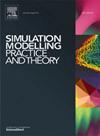Insights into the metal cutting contact zone through automation and multivariate regression modelling under the framework of gear skiving
IF 3.5
2区 计算机科学
Q2 COMPUTER SCIENCE, INTERDISCIPLINARY APPLICATIONS
引用次数: 0
Abstract
The modern time of Industry 4.0 requires an enhanced prediction process for reliable and sustainable manufacturing. It is essential to understand the relationships between various process parameters of machining for better optimization. Digitalization offers the opportunity to accelerate the prediction process using different modelling such as numerical and data-driven models. Improvements in the knowledge of thermo-mechanical variables and the use of finite element method (FEM) tools and machine learning approaches for thorough thermo-mechanical analysis are noteworthy contributions to the area. However, an ideal standardized approach remains to be resolved. Therefore, this research proposes a development process of an automated FEM tool to simulate the tool-chip interaction for AISI4140 material, coupled with a hybrid multivariate regression model for fast prediction of non-linear relationships between the cutting parameters and the contact properties. Consequently, the study also interprets the tool-chip interactions in the secondary deformation zone, facilitating process optimization for improved machining performance.

在齿轮切削的框架下,通过自动化和多元回归建模深入了解金属切削接触区
现代工业4.0时代需要一个增强的预测过程,以实现可靠和可持续的制造。为了更好地优化加工,了解各种工艺参数之间的关系是至关重要的。数字化提供了使用不同模型(如数值模型和数据驱动模型)加速预测过程的机会。热-机械变量知识的改进以及使用有限元方法(FEM)工具和机器学习方法进行彻底的热-机械分析是该领域值得注意的贡献。然而,理想的标准化方法仍有待解决。因此,本研究提出了一种模拟AISI4140材料刀片交互作用的自动化有限元工具的开发过程,并结合混合多元回归模型快速预测切削参数与接触特性之间的非线性关系。因此,该研究还解释了刀具-切屑在二次变形区的相互作用,有助于工艺优化以提高加工性能。
本文章由计算机程序翻译,如有差异,请以英文原文为准。
求助全文
约1分钟内获得全文
求助全文
来源期刊

Simulation Modelling Practice and Theory
工程技术-计算机:跨学科应用
CiteScore
9.80
自引率
4.80%
发文量
142
审稿时长
21 days
期刊介绍:
The journal Simulation Modelling Practice and Theory provides a forum for original, high-quality papers dealing with any aspect of systems simulation and modelling.
The journal aims at being a reference and a powerful tool to all those professionally active and/or interested in the methods and applications of simulation. Submitted papers will be peer reviewed and must significantly contribute to modelling and simulation in general or use modelling and simulation in application areas.
Paper submission is solicited on:
• theoretical aspects of modelling and simulation including formal modelling, model-checking, random number generators, sensitivity analysis, variance reduction techniques, experimental design, meta-modelling, methods and algorithms for validation and verification, selection and comparison procedures etc.;
• methodology and application of modelling and simulation in any area, including computer systems, networks, real-time and embedded systems, mobile and intelligent agents, manufacturing and transportation systems, management, engineering, biomedical engineering, economics, ecology and environment, education, transaction handling, etc.;
• simulation languages and environments including those, specific to distributed computing, grid computing, high performance computers or computer networks, etc.;
• distributed and real-time simulation, simulation interoperability;
• tools for high performance computing simulation, including dedicated architectures and parallel computing.
 求助内容:
求助内容: 应助结果提醒方式:
应助结果提醒方式:


